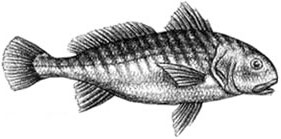Appearance

Scientific Name
Micropogonias undulatus
Market Forms
Usually sold whole; dressed. Recently, larger fish are available that can be filleted. Size
The average croaker weighs in at 1/2 to 2 lbs. Taste/Texture
Tender meat with a mild, sweet flavor.
Seasonality
Croaker is found in nearshore and Chesapeake Bay waters during the spring, summer and fall, and are available further south and offshore during the winter months. Nutritional Value
104 Calories (100 grams, 3.5 oz.)
17.8% Protein
3.2% Fat
.22% Omega-3 Substitutability
Similar in taste to the spot, black sea bass, lake trout or white perch, among others. Larger fillets can be substituted for striped bass, catfish, and snapper. Folklore
Anyone who has ever caught a croaker, knows how it got its name. But no one really knows why the “talking fish”talks—whether to keep in touch with other members of the school, to echo sound for depth or to express itself during breeding season. Its loud and distinctive “voice”did manage to foil the U.S. Government and scientists during WWII when a hydrophone system set up in the Chesapeake Bay to detect German submarines began to pick up incessant signals—as it turned out, the call of the croaker. This is no idle chatter! Harvesting
Croaker is one of Virginia’s most abundant fish. The haul seine, otter trawl, pound net and gill net are used by day boats to bring in the quantities of fish caught commercially every year.
Safety/Quality
Virginia’s waters and products are regulated by federal and state agencies including the FDA, the Virginia Department of Health, the Virginia Department of Agriculture and Consumer Services, the Virginia Department of Environmental Quality, and the Virginia Marine Resources Commission, insuring that only safe wholesome seafood reaches our customers.

